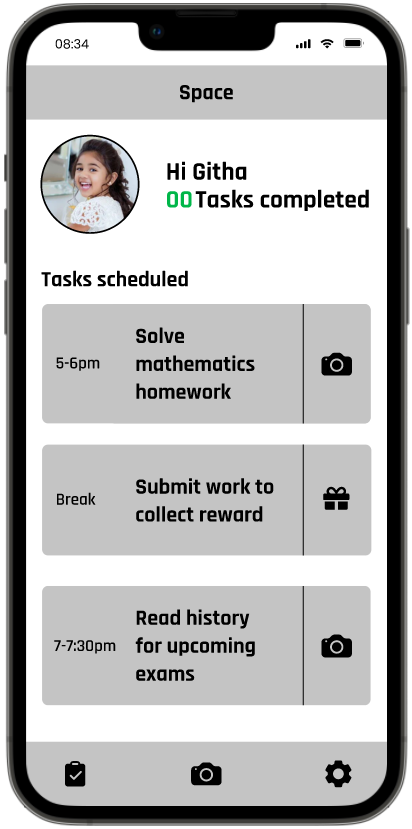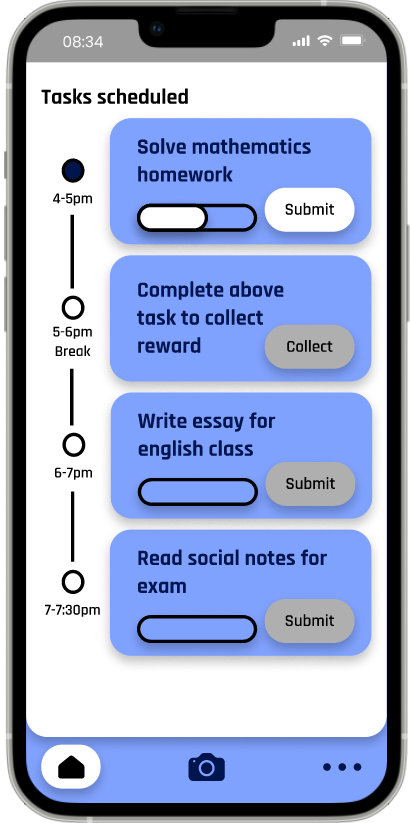

Enabling child ADHD individuals manage their daily workflow through a dual device application.
• User Research: Surveys, Competitive Analysis, Interviews,
User testing, Affinity Mapping
• Storytelling &
Narrative
• UX Design: sketches, Iterative Wireframing,
low and high fidelity prototyping, Testing Sessions
• Solo Project
• Jan 2022 -2 week
• Figma
• Miro

Every year, around 10 million new ADHD(Attention deficit
hyperactivity disorder) cases arise. ADHD is one of the most common
neurodevelopmental disorders of childhood. It is usually first
diagnosed in childhood and often lasts into adulthood.
However, ADHD doesn't affect a child's knowledge or creativity. But
ADHD can affect a student's ability to focus, pay attention, listen,
or put effort into schoolwork. ADHD also can make a student fidgety,
restless, talk too much, or disrupt the class. Kids with ADHD might
also have learning disabilities that cause them to have problems in
school.
As an ADHD child, the biggest hurdle is to do work in proper order
and schedule tasks. This is where parents come in and help them get
over ADHD. But parents can't be there for a child in every case. And
also ADHD children should be able to plan their own tasks eventually
after a certain age. But this transition gets very hard for an ADHD
child to cope up with.

1. I conducted interviews with 14 invidual(10 parents and 4 ADHD
children) and created empathy maps to understand the users.
2. Primary user groups were identified through research Was
parents with ADHD children who are striving for support.
3. This user group confirmed initial assumptions about the Space
app, but research also revealed people are expecting to have
better features that will encourage the child even when parents
are not around.
4. Other user problems included obligations that imply that
children won’t stay motivated on task when the reward is to be
given by parents because parents easily bend towards children if
they get overwhelmed.
• ADHD in children can be avoided with some traditional task
scheduling and rewards after a task.
• But as a child, they need the help of parents to support
them in every step to gain motivation and guide them to
compete with their tasks.
• There may be possibilities that they may not get the help of
parents as they grow up, so they need to start planning for
themselves eventually.
• But as a ADHD child the transition can be hard to plan
things and follow it on scheduled time basis.


As a child they need parents to be with them and plan every step so that they can concentrate on the current task without any deviation.
It's common for ADHD children to lose motivation when they can't finish the task on time or they can't finish a task. This eventually leads to neglecting the current task
Even though the child can send photos of finished work to parents when they are not home. Giving the freedom of phones will eventually make them deviate from their current task.
The app is used as a dual device app with parent and child devices linked with the same email account. logging in as a parent device enables parents to create new tasks remotely and children can continue with them visualizing tasks in the child device and submit in-app for verification by parents. And ADHD mode in child device will lock the mobile to Space app to maintain no distractions.
Children with ADHD lose motivation when they frequently encounter things that feel hard or experience a failure like not completing a task on time. But a win in this situation will regain their stability. So a mini-game is designed to show up at a time when the child is not able to complete the task on time. The game is designed in such a way that if a child misses his deadline the game is pretty easy to regain his confidence and if he completes the tasks on time the game gets challenging.
The medically most feasible treatment for ADHD is to give rewards after the task completion. In generation-z, even children use social media so the best reward is to greet them with a sticker that can be used in the camera feature inside the app and can be shared across.
The best game that suits our needs and lend out creativity and is
processively achievable for any ADHD is Minecraft. But Minecraft is
designed so that it is an endless adventure of exploring the virtual
world and creativity. So for ADHD, it has to be redesigned into a
task accomplishment game where we need to craft given item in a
certain time while exploring and collecting. Moreover, the task
difficulty changes to Space app user current Completion record of
the current schedule.
For example: The game tasks child to find sand and make glass out of
it, with the help of ques in-app.








• 6 people have participated in user testing out of which 3 are
parents and 3 are children.
• Jan 2022 -1 week
Based on the theme that: Parent users want to be able to change from child to parent device(vice-versa) in-app, an insight is: users need a more intuitive way to shi from child to parent device(vice-versa) in-app.
Based on the theme that: Child users want to visualize timer on the current task, an insight is: users need a more intuitive way to visualize the current task timer.
Based on the theme that: for most child users, it’s not immediately clear how the timeline works, an insight is: child users need a more intuitive design to make a clear picture of the timeline.
As per research insights, new adaptations have been made into lofi prototypes to continue with the hifi prototypes.


As per research insights, I enabled the Space app with easy device switching. now users switch from parent device to child device or vice-versa in settings pannel using use as an option.


As the Space app is for ADHD child users the app has been adapted to subtle colors to make it more playful and a task timer to have a more in-depth experience.


The main user flow is to follow the current task that has been scheduled by parents. So the Space app has been adapted to have a more visually and usably speculating timeline.
Hifi prototypes for mobile.

Parents' login/signup is straightforward using their mail credentials. child login does also requires parent email id so the sync is easy and we can have easy device switch. And users are given tips on first login.
The parent's user flow is set to be simple because Space apps main theme is to decrease the burden on parents who support their ADHD child.
ADHD children may have problems with anger management, so the whole color palette is chosen to be subtle so it gives a peaceful touch on the user. The user flow is built so that as a child they won't get irritated by complex structures.
Space app has been adapted to multiple screens using responsive web design concepts. Responsive web design was made within the continuity and consistency of mobile app to make users more familiar across the devices.

• Building empathy for a user population I did not know a lot
about has helped me grow immensely as a designer.
• During
my observation sessions initially, and conducting many usability
sessions with these children has made me realize how important
real-world context is, and how much more you can learn about
your user by being with them instead of reading about them.